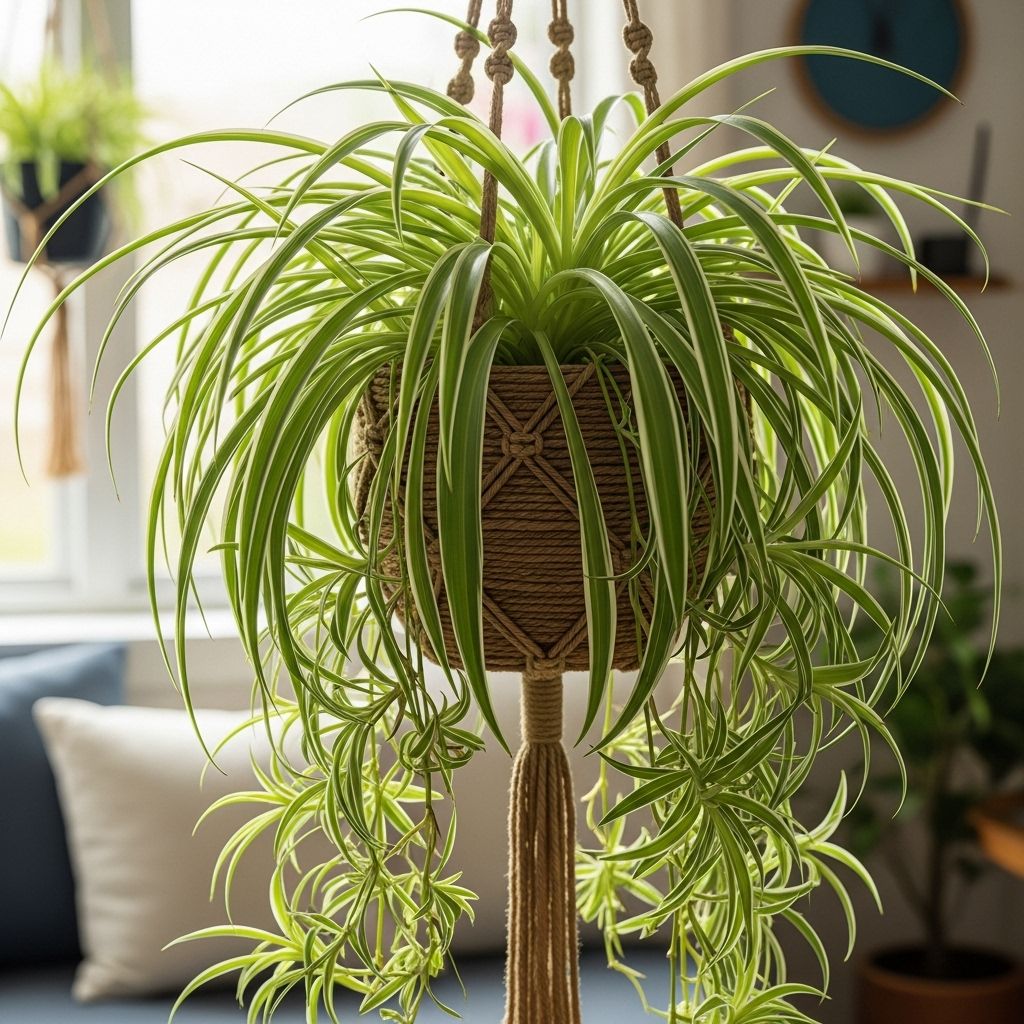How To Grow Spider Plants In Hanging Baskets: 7 Essential Tips
Master the art of growing vibrant spider plants in hanging baskets with practical tips on placement, soil, watering, and care.

Image: HearthJunction Design Team
7 Essential Tips for Growing Lush Spider Plants in Hanging Baskets
Spider plants (Chlorophytum comosum) are a favorite among indoor plant enthusiasts and for good reason. These hardy, attractive houseplants are especially well-suited for hanging baskets, where their arching leaves and cascading plantlets can truly shine. In this comprehensive guide, you’ll learn everything you need to know to grow and maintain stunning spider plants in hanging baskets, from selecting the right basket to perfecting watering routines and solving common problems.
Contents
- Why Grow Spider Plants in Hanging Baskets?
- 1. Choose the Right Hanging Basket
- 2. Pick a Light and Durable Container Material
- 3. Use the Correct Potting Soil
- 4. Find the Perfect Placement
- 5. Master Watering Techniques
- 6. Routine Maintenance and Fertilization
- 7. Troubleshooting Common Problems
- Frequently Asked Questions
Why Grow Spider Plants in Hanging Baskets?
Spider plants are renowned for their graceful, arching leaves and the distinctive plantlets (“spiderettes”) that dangle from long stems. Displayed in a hanging basket, these features are highlighted, turning any room into a lush, living display. Hanging baskets also keeps plants out of reach of pets or small children and makes full use of vertical space, ideal for apartments and homes with limited surfaces.
1. Choose the Right Hanging Basket
The choice of hanging basket sets the foundation for a healthy, attractive spider plant. Here’s what to keep in mind:
- Size Matters: Spider plants have modest root systems, so a basket that is just a few inches wider than the root ball is sufficient. Avoid overly large containers, which can lead to excess moisture retention and root rot.
- Drainage: Essential for spider plants. Always use baskets with ample drainage holes to prevent soggy soil, which spider plants cannot tolerate.
- Accessibility: Make sure the basket is easy to take down for watering and maintenance.
2. Pick a Light and Durable Container Material
The material of your hanging basket affects both plant health and convenience. Consider using:
- Plastic: Lightweight and retains moisture well but can become brittle over time.
- Coconut coir or moss liners: Promote good airflow and drainage but dry out quickly and may require more frequent watering.
- Wire baskets: Durable and allow for decorative liners but ensure drainage is not compromised.
Whichever material you select, balance weight (for easy hanging) and suitability for the indoor environment.
3. Use the Correct Potting Soil
Soil quality is crucial for vibrant spider plants. Key considerations:
- Well-Draining & Airy Mix: Spider plants thrive in a loose, well-aerated potting mix. Dense, water-retentive soil can cause root rot and stifle growth.
- Soilless Mixes: Many houseplant-specific mixes are ideal when amended with perlite or orchid bark to improve drainage.
- DIY Blend: Combine standard potting soil with equal parts perlite and peat moss or coconut coir to create a custom mix that supports healthy root development.
4. Find the Perfect Placement
Light is one of the most critical factors impacting a spider plant’s health:
- Bright, Indirect Light: Position the hanging basket near a window with filtered sunlight. Spider plants grow best with plentiful but indirect light; harsh sun can scorch their leaves, while too little light stunts growth and dulls color.
- Best Windows: East-facing windows provide gentle morning light, while north-facing windows offer soft, consistent brightness. South- and west-facing windows require sheer curtains to diffuse the sun, especially in the afternoon.
- Avoid Temperature Extremes: Keep spider plants away from heat sources like radiators, as well as cold drafts or air conditioning vents. They prefer temperatures between 60–75°F (16–24°C) and can suffer if exposed to temperatures below 55°F (13°C).
5. Master Watering Techniques
Overwatering is a common issue with spider plants in hanging baskets. Follow these guidelines:
- Let the Soil Dry Slightly: Water when the top inch of soil feels dry to the touch. Spider plants prefer to dry out a bit between waterings, and consistent overwatering leads to soggy soil and root rot.
- Even Moisture: When you do water, soak the soil thoroughly until water drains from the bottom. Always discard excess water to avoid standing moisture at the roots.
- Check Drainage: Periodically inspect basket drainage holes to prevent clogging.
- Reduce Watering in Winter: Growth slows in cooler months, so reduce the frequency of watering accordingly.
| Season | Watering Frequency |
|---|---|
| Spring/Summer | Every 7–10 days, or when top inch of soil is dry |
| Fall/Winter | Every 2–3 weeks, or as needed |
6. Routine Maintenance and Fertilization
Keeping your spider plant looking its best involves a few simple outdoor maintenance practices:
- Fertilization: Feed monthly during the growing season (spring and summer) with a balanced, water-soluble houseplant fertilizer at half strength. Avoid over-fertilizing, as spider plants are sensitive to salt buildup, which can cause brown leaf tips.
- Pruning: Snip off dead, yellow, or brown leaves and faded flower stalks to encourage new growth and tidy appearance.
- Repotting: Spider plants grow quickly and may become rootbound. Repot every 1–2 years, choosing a basket just one size up to prevent excess moisture retention.
- Propagating Plantlets: The small spiderettes can be easily removed and rooted in soil or water to start new plants or to fill out an existing basket for a fuller look.
7. Troubleshooting Common Problems
- Brown Tips: Often a result of fluoride in tap water, salt buildup from fertilizer, or inconsistent watering. Use distilled or rainwater and flush the soil occasionally by watering thoroughly to remove excess salts.
- Wilting or Yellowing Leaves: Can indicate overwatering, underwatering, or rootbound conditions. Assess soil moisture and root health.
- Slow Growth or Crispy Edges: Suggests inadequate light or low humidity. Increase light (without direct sun) and consider misting the plant or placing a water tray nearby in dry climates.
- Pests: Spider plants are generally pest-resistant but may occasionally attract spider mites, aphids, or mealybugs. Treat infestations promptly with insecticidal soap or a gentle wipe-down.
Frequently Asked Questions (FAQs)
Q: Are spider plants pet-safe?
A: Yes, spider plants are non-toxic to cats and dogs. However, some pets may be drawn to chew on the leaves, which can cause vomiting if consumed in large quantities.
Q: How often should spider plants be repotted?
A: Spider plants should be repotted every 1–2 years or when the roots start to outgrow the basket, indicated by roots poking out from drainage holes or the soil becoming rootbound.
Q: What causes spider plant leaves to turn brown or yellow?
A: Brown tips are typically due to salt or mineral buildup, low humidity, over-fertilization, or inconsistent watering. Yellowing leaves can result from too much water or too little light. Adjust water, fertilization, or placement as needed.
Q: Can spider plants tolerate low light?
A: Spider plants will survive in lower-light areas but may lose some of their vibrant color and grow more slowly. They thrive best in bright, indirect light.
Q: How do you propagate spider plant babies?
A: Detach plantlets from the main plant and root them in moist potting soil or a glass of water. Once roots have developed, plant them in their own basket or share with friends.
Final Thoughts
Spider plants in hanging baskets are a timeless choice for enhancing indoor spaces with lush greenery and dynamic form. By selecting the right basket, using a suitable soil mix, providing proper light, and mastering watering and maintenance habits, you’ll be rewarded with vigorous, healthy plants that can last for years. Whether you’re a beginner or a seasoned plant parent, spider plants offer beauty, resilience, and easy propagation—making them a delight in any home or office setting.
References
- https://www.epicgardening.com/spider-plants-hanging-baskets/
- https://succulentsbox.com/blogs/blog/how-to-care-for-spider-plant
- https://www.gardeningknowhow.com/houseplants/spider-plant/how-to-grow-a-hanging-spider-plant
- https://raywiegandsnursery.com/products/bonnie-spider-plant-hanging-basket
- https://www.youtube.com/watch?v=m0IY3ezkCdg
Read full bio of medha deb












